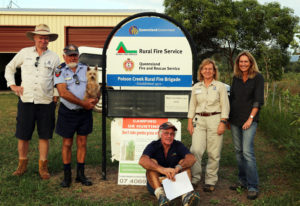26 June 2017
As part of their fire and weeds project, Hub researchers Dr Natalie Rossiter-Rachor from Charles Darwin University and Professor Samantha Setterfield from the University of Western Australia were recently invited to meet with Cook Shire Pests and Weeds Committee on Cape York Peninsula to discuss the risks, impacts and management options for the invasive gamba grass in the region.
Dr Rossiter-Rachor says that gamba grass fires pose risks to people and property, and increased costs to the agricultural, pastoral and horticultural industries in Australia.
“The high biomass produced by gamba grass means that fires burn hotter, spread more quickly and are more intense than when native grass burn,” Dr Rossiter-Rachor explained.
“Gamba grass has been identified as one of the highest priority weeds in Cook Shire. It is in the early stages of invasion in Queensland, so it’s critical to implement management strategies to prevent further spread and prevent future impacts.”
While in Queensland, Professor Setterfield and Dr Rossiter-Rachor also travelled to the Atherton tablelands to document the spread of gamba grass around the Mareeba area. The NESP project leaders also met with representatives from Qld Parks and Wildlife, Biosecurity Queensland and CSIRO about research needs for improving control options, such as testing the cost-efficiency of different herbicides and spraying equipment.
For more information, see the project start-up factsheet or contact Project Leader Dr Natalie Rossiter-Rachor at natalie.rossiter@cdu.edu.au.

Meeting at the Poison Creek Rural Fire Brigade in Cook Shire Qld. Photo by Natalie Rossiter-Rachor.
Want to know more about the Resilient Landscapes Hub's activities and our research into practical solutions to environmental problems? Stay informed about activities, research, publications, events and more through the Hub newsletter.
"*" indicates required fields